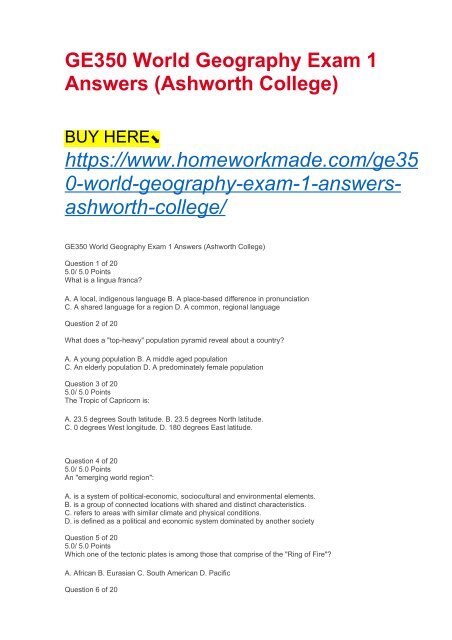GE350 World Geography Exam 1 Answers (Ashworth College)
Create successful ePaper yourself
Turn your PDF publications into a flip-book with our unique Google optimized e-Paper software.
<strong>GE350</strong> <strong>World</strong> <strong>Geography</strong> <strong>Exam</strong> 1<br />
<strong>Answers</strong> (<strong>Ashworth</strong> <strong>College</strong>)<br />
BUY HERE⬊<br />
https://www.homeworkmade.com/ge35<br />
0-world-geography-exam-1-answersashworth-college/<br />
<strong>GE350</strong> <strong>World</strong> <strong>Geography</strong> <strong>Exam</strong> 1 <strong>Answers</strong> (<strong>Ashworth</strong> <strong>College</strong>)<br />
Question 1 of 20<br />
5.0/ 5.0 Points<br />
What is a lingua franca?<br />
A. A local, indigenous language B. A place-based difference in pronunciation<br />
C. A shared language for a region D. A common, regional language<br />
Question 2 of 20<br />
What does a "top-heavy" population pyramid reveal about a country?<br />
A. A young population B. A middle aged population<br />
C. An elderly population D. A predominately female population<br />
Question 3 of 20<br />
5.0/ 5.0 Points<br />
The Tropic of Capricorn is:<br />
A. 23.5 degrees South latitude. B. 23.5 degrees North latitude.<br />
C. 0 degrees West longitude. D. 180 degrees East latitude.<br />
Question 4 of 20<br />
5.0/ 5.0 Points<br />
An "emerging world region":<br />
A. is a system of political-economic, sociocultural and environmental elements.<br />
B. is a group of connected locations with shared and distinct characteristics.<br />
C. refers to areas with similar climate and physical conditions.<br />
D. is defined as a political and economic system dominated by another society<br />
Question 5 of 20<br />
5.0/ 5.0 Points<br />
Which one of the tectonic plates is among those that comprise of the "Ring of Fire"?<br />
A. African B. Eurasian C. South American D. Pacific<br />
Question 6 of 20
0.0/ 5.0 Points<br />
What is the social category that developed during the 19th century of European imperialism?<br />
A. Gender B. Ethnicity C. Race D. Class<br />
Question 7 of 20<br />
5.0/ 5.0 Points<br />
__________ is the study of how the Earth's physical features are formed.<br />
A. Biogeography B. Cartography C. Geomorphology D. Zoogeography<br />
Question 8 of 20<br />
Trade Winds blow from which direction?<br />
A. East B. South C. North D. West<br />
Question 9 of 20<br />
5.0/ 5.0 Points<br />
What is the spatial dispersion of a previously homogenous group?<br />
A. Diaspora B. Fundamentalism C. Cultural displacement D. Ethnic differentiation<br />
Question 10 of 20<br />
0.0/ 5.0 Points<br />
Which of the following is the estimate of the total value of everything produced by a country in a particular<br />
year?<br />
A. Gross domestic product B. Gross national income C. Purchasing power parity<br />
D. Trade deficit<br />
Question 11 of 20<br />
5.0/ 5.0 Points<br />
Which of the following is NOT true respecting multinational corporations (MNCs)?<br />
A. They outsource jobs to places with cheaper labor.<br />
B. They offshore key assets to host banking countries.<br />
C. They move jobs away from places with regulated labor laws.<br />
D. They seek to balance a living wage with optimal productivity.<br />
Question 12 of 20<br />
5.0/ 5.0 Points<br />
Extractive activities are considered to be what sector of the economy?<br />
A. quaternary B. tertiary C. secondary D. primary<br />
Question 13 of 20<br />
5.0/ 5.0 Points<br />
According to the human development index devised by the United Nations, a country with a perfect score<br />
would have an index of:<br />
A. .001. B. 10. C. 100. D. 1.0.<br />
Question 14 of 20<br />
5.0/ 5.0 Points<br />
The U.N. Human Development Index (HDI) is based on:<br />
A. life expectancy, education, fertility rate. B life expectancy, education, income.<br />
C. education, income, death rate. D. education, income, fertility rate.<br />
Question 15 of 20<br />
0.0/ 5.0 Points<br />
Regarding the Tabula Rogeriana all of the following are true, EXCEPT:
A. it is a "map of the known world" in 1154.<br />
B. it was created by the Islamic cartographer Muhammed al-Idrisi.<br />
C. it includes Europe, Asia, and North Africa.<br />
D. it was the first map outlining the New <strong>World</strong>.<br />
Question 16 of 20<br />
Commodity chains begin with the:<br />
A. extraction and production of raw materials.<br />
B. manufacture and export of commodities.<br />
C. high wage, semi-skilled assembly of consumer products.<br />
D. delivery and consumption of finished commodities.<br />
Question 17 of 20<br />
Which region hosts more than half of the world's biodiversity?<br />
A. Africa B. North America C. Latin America and Caribbean D. South Asia<br />
Question 18 of 20<br />
When was the beginning of the Anthropocene epoch?<br />
A. 1550 B. 1750 C. 1650 D. 1850<br />
Question 19 of 20<br />
What country promised to have achieved net zero emissions by 2020 in the 2015 Paris Agreement?<br />
A. U.S. B. Denmark C. Costa Rica D. India<br />
Question 20 of 20<br />
5.0/ 5.0 Points<br />
Respecting colonialism, the first wave, extending into the early 1800s, was dominated by:<br />
A. China. B. Great Britain. C. Spain and Portugal. D. Dutch Netherlands.

















